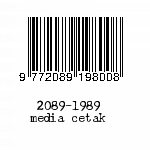Analisis Inflation Targeting Framework (ITF) dan Perubahan Respon Kebijakan Moneter
Abstract
The purpose of this study is to determine how the implementation of inflation targeting framework (ITF) and how the changes in monetary policy response. The data period starts from 2014 to 2023, with monthly data. The data analysis method used is a model of two interrelated simultaneous equations, called Two Stage Least Square (2SLS). The results of this study explain that the exogenous variables in the first equation of real interest rates, inflation, inflation gap, output gap have a positive and significant effect on the BI rate. Exogenous variables in the second equation, namely inflation target, BI rate, exchange rate, WTI world oil price have a positive and significant effect on inflation. However, the output gap has a negative and significant effect on inflation, and the money supply has no significant effect on inflation. The change in monetary policy response is seen from the increase or decrease of BI rate by 25 Basis points
References
Arisandy, D. A. (2016). Analisis model Taylor rule dalam penerapan inflation targeting framework di Indonesia. Jurnal Ilmiah Mahasiswa FEB, 4(2), 1–12. https://doi.org/10.1108/978-1-78973-751-620191006.
Bank Indonesia. (2018). Laporan kebijakan moneter triwulan II vol. II. Departemen Kebijakan Ekonomi dan Moneter (Ed.).
Bank Indonesia. (2023). Sejarah Bank Indonesia. https://www.bi.go.id/id/tentang-bi/sejarah-bi/Default.aspx.
Bårdsen, G., Eitrheim, Ø., Jansen, E. S., & Nymoen, R. (2023). The new Keynesian Phillips curve. The Econometrics of Macroeconomic Modelling, 2005(1968), 127–146. https://doi.org/10.1093/oso/9780199246496.003.0007.
Batarseh, A. (2021). The nature of the relationship between the money supply and inflation in the Jordanian economy (1980–2019). Banks and Bank Systems, 16(2), 38–46. https://doi.org/10.21511/bbs.16(2).2021.04.
Binici, M., Kara, H., & Özlü, P. (2018). Monetary transmission with multiple policy rates: Evidence from Turkey. Applied Economics, 51(17), 1–25. https://doi.org/10.1080/00036846.2018.1529400.
BPS. (2023). Laporan perekonomian Indonesia. Badan Pusat Statistik Indonesia.
Brown, H. G. (2023). Fisher’s purchasing power of money. The Quarterly Journal of Economics, 26(1), 140–151. https://doi.org/10.2307/1884528.
Buffie, E. F., Airaudo, M., & Zanna, F. (2018). Inflation targeting and exchange rate management in less developed countries. Journal of International Money and Finance, 81, 159–184. https://doi.org/10.1016/j.jimonfin.2017.09.013.
Chan, J. C. C., Clark, T. E., & Koop, G. (2018). A new model of inflation, trend inflation, and long-run inflation expectations. Journal of Money, Credit and Banking, 50(1), 5–53. https://doi.org/10.1111/jmcb.12452.
Chevapatrakul, T., & Paez-Farrell, J. (2018). How effective is inflation targeting in emerging market economies. In Economics (Ed.), Sheffield Economic Research Paper Series. The University Of Sheffield.
Daboussi, O. (2016). Enhanced economic stability and the role of inflation targeting policy: Empirical study on case of developing countries. Asian Economic and Financial Review, 6(1), 352–362. https://doi.org/10.18488/JOURNAL.AEFR/2016.6.6/102.6.352.362.
Djaali. (2021). Metodologi penelitian kuantitatif. Bumi Aksara.
Emam, H. A. (2021). Interest rate setting in Egypt: a NARDL approach for estimating backward-looking monetary policy reaction function. Applied Economics, Vol. 53(57), 6655–6669. https://doi.org/10.1080/00036846.2021.1948961.
Fitri, K. (2022). Pengaruh inflasi, nilai tukar (kurs) dan suku bunga terhadap IHSG di Bursa Efek Indonesia periode 2016-2020. Ecountbis (Economics, Accounting and Business Journal), 2(1), 223–232. https://doi.org/10.32493/jism.v3i4.34399.
Ghozali, I., & Ratmono, D. (2019). Analisis multivariant dan ekonometrika: Teori, konsep dan aplikasi dengan EViews 10. UNDIP Press.
Gujarati, D. N. (2011). Dasar-dasar ekonometrika (Buku 1). Salemba Empat.
Hommes, C., & Lustenhouwer, J. (2019). Inflation targeting and liquidity traps under endogenous credibility. Journal of Monetary Economics, 107, 48–62. https://doi.org/10.1016/j.jmoneco.2019.01.027.
Ika, S. Z. K. S. (2016). Transmisi BI rate sebagai instrumen untuk mencapai sasaran kebijakan moneter. Kajian Ekonomi Dan Keuangan, 20(3), 261–284. https://doi.org/10.31685/kek.v20i3.208.
Ismayani, A. (2021). Metodologi penelitian. Syiah Kuala University Press.
Junankar, P., & Wong, C. Y. (2020). The impact of inflation targeting on inflation and growth: How robust is the evidence? IZA Institute of Labor Economics Discussion Paper Series, IZA DP No. 13284. https://doi.org/10.2139/ssrn.3608533.
Käfer, B. (2014). The Taylor rule and financial stability – A literature review with application for the Eurozone. Review of Economics, 65(2), 159–192. https://doi.org/10.1515/roe-2014-0204.
Kamber, G., & Wong, B. (2020). Global factors and trend inflation. Journal of International Economics, 122, 103265. https://doi.org/10.1016/j.jinteco.2019.103265.
Kenward, L. R. (2013). Inflation targeting in Indonesia, 1999–2012: An ex-post review. Bulletin of Indonesian Economic Studies, 49(3), 305–327. https://doi.org/10.1080/00074918.2013.850630.
Keynes, J. M. (1936). The general theory of employment. In The General Theory of Employment, Interest and Money (2007th ed.). Palgrave Macmillan.
Kruvsković, B. D. (2017). Exchange rate and interest rate in the monetary policy reaction function. Journal of Central Banking Theory and Practice, 6(1), 55–86. https://doi.org/10.1515/jcbtp-2017-0004.
Li, Y., & Guo, J. (2022). The asymmetric impacts of oil price and shocks on inflation in BRICS: A multiple threshold nonlinear ARDL model. Applied Economics, 54(12), 1377–1395. https://doi.org/10.1080/00036846.2021.1976386.
Lubis, I., Syamruddin, S., Astuti, E., & Pemana, A. (2020). Inflation targeting framework (ITF) and Indonesia stable market index. Proceedings of the 3rd International Conference on Advance & Scientific Innovation (ICASI) 2020, 2, 1–7. https://doi.org/10.4108/eai.20-6-2020.2300635.
Lubis, S. N., & Soemitra, A. (2022). Evaluation of the regional inflation control team’s (TPID) performance on the Medan City economy. Jurnal EMBA: Ekonomi, Bisnis, Manajemen, 2(1), 191–200. http://dx.doi.org/10.53697/emba.v2i1.561.
Luwihadi, N. L. A., & Arka, S. (2017). Determinan jumlah uang beredar dan tingkat inflasi di Indonesia periode 1984-2014. E-Jurnal Ekonomi Pembangunan Universitas Udayana, 6(4), 472-676. https://doi.org/10.1108/978-1-78973-751-620191008.
Mackiewicz-Łyziak, J. (2016). Active and passive monetary policy in CEE countries with inflation targeting: The case of the Czech Republic, Hungary, and Poland. Eastern European Economics, 54(2), 133–152. https://doi.org/10.1080/00128775.2015.1126789.
Mahendra, A., Amalia, M. M., & Leon, H. (2022). Analisis pengaruh suku bunga, harga minyak dunia, harga emas dunia terhadap indeks harga saham gabungan dengan inflasi sebagai variabel moderating di Indonesia. Owner, 6(1), 1069–1082. https://doi.org/10.33395/owner.v6i1.725.
Mankiw, N. G. (2006). Pengantar ekonomi makro. Alihbahasa: Chriswan Sungkono. Salemba Empat.
Mishkin, F. S. (2021). The economics of money, banking, and applying theory to the real world. Pearson Education Limited.
Morozumi, A., Bleaney, M., & Mumuni, Z. (2020). Inflation targeting in low‐income countries: Does IT work? Review of Development Economics, 24, 1529–1550. https://doi.org/10.1111/RODE.12690.
Naraidoo, R., & Gupta, R. (2010). Modeling monetary policy in South Africa: Focus on inflation targeting era using a simple learning rule. International Business & Economics Research Journal (IBER), 9(12), 89–98. https://doi.org/10.19030/iber.v9i12.349.
OECD. (2024). OECD economic outlook, interim report february 2024. https://doi.org/10.1787/0fd73462-en.
Pohan, A. (2008). Kerangka kebijakan moneter & implementasinya di Indonesia. PT. Raja Grafindo Persada.
Pratomo, W. A., & Hidayat, P. (2007). Pedoman praktis penggunaan Eviews dalam ekonometrika (1st ed.). Medan USU Press.
Rakhmat, Warjiyo, P., & Sadli, A. M. (2022). The influence of exchange rate and foreign capital on the performance of inflation targeting framework in Indonesia. International Journal of Sustainable Development and Planning, 17(5), 1585–1592. https://doi.org/10.18280/ijsdp.170523.
Ready, R. C. (2017). Oil prices and the stock market*. Review of Finance, 22(1), 155–176. https://doi.org/10.1093/rof/rfw071.
Sari, S. P., & Nurjannah, S. (2023). Analisis pengaruh nilai tukar, jumlah uang beredar dan BI rate terhadap inflasi di Indonesia dan dampaknya terhadap daya beli masyarakat. AKTIVA: Journal of Accountancy and Management, 1(1), 21–29. https://doi.org/10.24260/aktiva.v1i1.1015.
Siregar, R. A., Tanjung, A. A., & Sukardi, S. (2024). Analisis pengaruh E-money, jumlah uang beredar, kurs dan inflasi terhadap pertumbuhan ekonomi. Ekonomis: Journal of Economics and Business, 8(1), 88-93. https://doi.org/10.33087/ekonomis.v8i1.1218.
Siregar, R. P., Tanjung, A. A., & Syafii, M. S. (2023). Analysis of monetary policy mechanism in Indonesia through interest rate channels on the stock market. International Journal of Research and Review, 10(1), 284–303. https://doi.org/https://doi.org/10.52403/ijrr.20230132.
Soe, T., & Kakinaka, M. (2017). Inflation targeting and exchange market pressure in developing economies: Some international evidence. Finance Research Letters, 24, 263–272. https://doi.org/10.1016/J.FRL.2017.09.015.
Spahija, F. (2016). Analysis of the main theories of interest rates. International Journal of Economics, Commerce and Management, 4(6), 643–658. https://ijecm.co.uk/wp-content/uploads/2016/06/4639.pdf.
Sturzenegger, F. (2020). Macri’s macro: The elusive road to stability and growth. Brookings Papers on Economic Activity, 1, 339–436. https://doi.org/10.1353/eca.2019.0016.
Stylianou, T., Nasir, R., & Waqas, M. (2024). The relationship between money supply and inflation in Pakistan. PLOS ONE, 19(3), 1–13. https://doi.org/10.1371/journal.pone.0301257.
Suginam, S., Siska, E., & Hidayat, S. (2021). Pengaruh nilai tukar uang, jumlah uang beredar dengan kegiatan export terhadap inflasi pada masa pandemic Covid-19. Ekonomi, Keuangan, Investasi Dan Syariah (EKUITAS), 3(2), 33–38. https://doi.org/10.47065/ekuitas.v3i2.1032.
Tanjung, A. (2021). Bank lending channel of monetary policy transmission. Proceedings of the 1st International Conference on Social Science, Humanities, Education and Society Development, (ICONS) 2020, 3, 1–8. http://dx.doi.org/10.4108/eai.30-11-2020.2303764.
Tanjung, A. A., Afifuddin, S., Daulay, M., & Ruslan, D. (2017). Relationship between monetary policy, fiscal, country risk and macroeconomic variable in Indonesia. International Journal of Economic Research, 14(15), 207–219. https://www.researchgate.net/publication/329684119_Relationship_between_monetary_policy_fiscal_country_risk_and_macroeconomic_variable_in_Indonesia.
Tanjung, A. A., & Siswanto, A. A. (2022). Analisis kurva Phillips di Indonesia. Media Ekonomi, 30(1), 71–77. https://doi.org/10.25105/me.v30i1.10066.
Tanjung, A. A., Ruslan, D., Lubis, I., & Pratama, I. (2022). Stock market responses to Covid-19 pandemic and monetary policy in Indonesia: Pre and post vaccine. Cuadernos de Economia, 45(127), 120–129. https://doi.org/10.32826/cude.v1i127.610.
Tanjung, A. A., & Siswanto, A. A. (2021). Analysis of monetary policy transmission through inflation expectations: Indonesia, China, India (ICI). International Journal of Economics, Business and Management Research, 5(12), 101–112. https://doi.org/10.52403/ijrr.20210430.
Taylor, J. B. (1993). Discretion versus policy rules in practice. Carnegie-Rochester Conference Series on Public Policy, 39, 195–214. https://doi.org/10.1016/0167-2231(93)90009-L.
Upper, C., & Worms, A. (2002). Real long-term interest rates and monetary policy: A cross-country perspective. Bank for International Settlements. https://www.bis.org/publ/bppdf/bispap19j.pdf.
Vincent, O. (2021). Central Banks’ response to inflation, output gap, and exchange rate in Nigeria and South Africa. Cogent Business and Management, 8(1), 1–12. https://doi.org/10.1080/23311975.2021.1964689.
Warjiyo, P., & Juhro, S. M. (2019). Central Bank policy mix: Issues, challenges, and policy responses. BI Institute 2022. https://doi.org/10.1007/978-981-16-6827-2_4.
Yodiatmaja, B. (2012). Hubungan antara BI rate dan inflasi periode Juli 2005-Desember 2011: Uji kausalitas Toda-Yamamoto. Economics Development Analysis Journal, 1(1), 1–7. https://doi.org/10.15294/edaj.v1i2.473.
Zhao, L., Zhang, X., Wang, S., & Xu, S. (2016). The effects of oil price shocks on output and inflation in China. Energy Economics, 53, 101–110. https://doi.org/10.1016/j.eneco.2014.11.017.
Copyright (c) 2024 Ayu Angelina Pasaribu, Wahyu Ario Pratomo, Ahmad Albar Tanjung

This work is licensed under a Creative Commons Attribution-ShareAlike 4.0 International License.

















